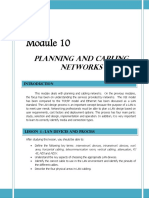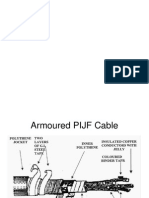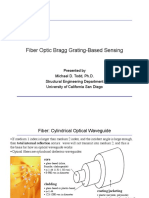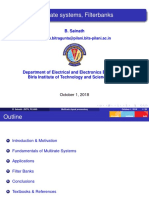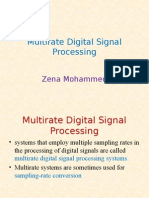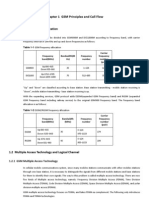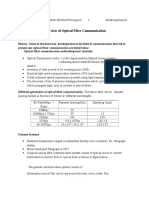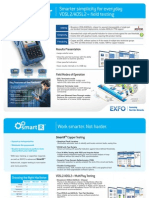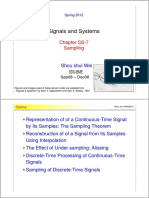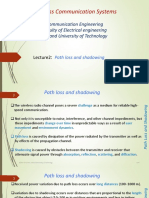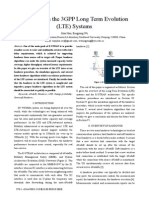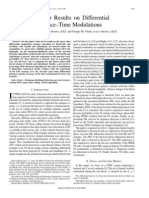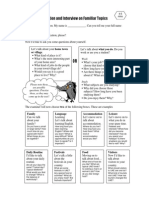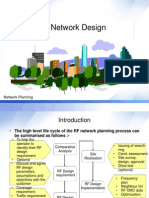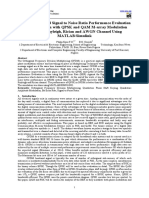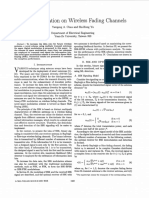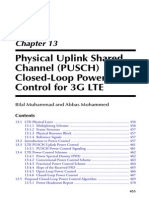Modelling of Comm Channels
Uploaded by
alansi92004Modelling of Comm Channels
Uploaded by
alansi92004Modeling of Wireless Communication Systems using MATLAB
Dr. B.-P. Paris Dept. Electrical and Comp. Engineering George Mason University
last updated September 23, 2009
2009, B.-P. Paris Pathloss and Link Budget
Wireless Communications
From Physical Propagation to Multi-Path Fading
Statistical Characterization of Channels
Part I The Wireless Channel
2009, B.-P. Paris
Wireless Communications
Pathloss and Link Budget
From Physical Propagation to Multi-Path Fading
Statistical Characterization of Channels
The Wireless Channel
Characterization of the wireless channel and its impact on digitally modulated signals. From the physics of propagation to multi-path fading channels. Statistical characterization of wireless channels:
Doppler spectrum, Delay spread Coherence time Coherence bandwidth
Simulating multi-path, fading channels in MATLAB. Lumped-parameter models:
discrete-time equivalent channel.
Path loss models, link budgets, shadowing.
2009, B.-P. Paris Pathloss and Link Budget Wireless Communications 3
From Physical Propagation to Multi-Path Fading
Statistical Characterization of Channels
Outline
Part III: Learning Objectives Pathloss and Link Budget From Physical Propagation to Multi-Path Fading Statistical Characterization of Channels
2009, B.-P. Paris
Wireless Communications
Pathloss and Link Budget
From Physical Propagation to Multi-Path Fading
Statistical Characterization of Channels
Learning Objectives
Understand models describing the nature of typical wireless communication channels.
The origin of multi-path and fading. Concise characterization of multi-path and fading in both the time and frequency domain.
Doppler spectrum and time-coherence Multi-path delay spread and frequency coherence
Appreciate the impact of wireless channels on transmitted signals.
Distortion from multi-path: frequency-selective fading and inter-symbol interference. The consequences of time-varying channels.
2009, B.-P. Paris Pathloss and Link Budget
Wireless Communications
From Physical Propagation to Multi-Path Fading
Statistical Characterization of Channels
Outline
Part III: Learning Objectives Pathloss and Link Budget From Physical Propagation to Multi-Path Fading Statistical Characterization of Channels
2009, B.-P. Paris
Wireless Communications
Pathloss and Link Budget
From Physical Propagation to Multi-Path Fading
Statistical Characterization of Channels
Path Loss
Path loss LP relates the received signal power Pr to the transmitted signal power Pt : Pr = Pt Gr Gt , LP
where Gt and Gr are antenna gains. Path loss is very important for cell and frequency planning or range predictions.
Not needed when designing signal sets, receiver, etc.
2009, B.-P. Paris Pathloss and Link Budget
Wireless Communications
From Physical Propagation to Multi-Path Fading
Statistical Characterization of Channels
Path Loss
Path loss modeling is more an art than a science.
Standard approach: t model to empirical data. Parameters of model:
d - distance between transmitter and receiver, fc - carrier frequency, hb , hm - antenna heights, Terrain type, building density, . . ..
2009, B.-P. Paris
Wireless Communications
Pathloss and Link Budget
From Physical Propagation to Multi-Path Fading
Statistical Characterization of Channels
Example: Free Space Propagation
In free space, path loss LP is given by Friiss formula: LP = 4 d c
2
4 fc d c
Path loss increases proportional to the square of distance d and frequency fc .
In dB: LP (dB ) = 20 log10 ( c ) + 20 log10 (fc ) + 20 log10 (d ). 4
Example: fc = 1GHz and d = 1km LP (dB ) = 146 dB + 180 dB + 60 dB = 94 dB.
2009, B.-P. Paris Pathloss and Link Budget Wireless Communications 9
From Physical Propagation to Multi-Path Fading
Statistical Characterization of Channels
Example: Two-Ray Channel
Antenna heights: hb and hm . Two propagation paths:
1. direct path, free space propagation, 2. reected path, free space with perfect reection.
Depending on distance d , the signals received along the two paths will add constructively or destructively. Path loss: 1 LP = 4 For d 4 fc d c
2
1
b hm sin( 2ch ) fc d
hb hm , path loss is approximately equal to: LP d2 hb hm
2
Path loss proportional to d 4 is typical for urban environment. 2009, B.-P. Paris Wireless Communications
10
Pathloss and Link Budget
From Physical Propagation to Multi-Path Fading
Statistical Characterization of Channels
Okumura-Hata Model for Urban Area
Okumura and Hata derived empirical path loss models from extensive path loss measurements.
Models differ between urban, suburban, and open areas, large, medium, and small cities, etc.
Illustrative example: Model for Urban area (small or medium city) LP (dB ) = A + B log10 (d ), where A = 69.55 + 26.16 log10 (fc ) 13.82 log10 (hb ) a(hm ) B = 44.9 6.55 log10 (hb ) a(hm ) = (1.1 log10 (fc ) 0.7) hm (1.56 log10 (fc ) 0.8)
2009, B.-P. Paris Pathloss and Link Budget Wireless Communications 11
From Physical Propagation to Multi-Path Fading
Statistical Characterization of Channels
Signal and Noise Power
Received Signal Power: Gr Gt , LP LR where LR is implementation loss, typically 2-3 dB. (Thermal) Noise Power: Pr = Pt PN = kT0 BW F , where
k - Boltzmanns constant (1.38 1023 Ws/K), T0 - temperature in K (typical room temperature, T0 = 290 K), kT0 = 4 1021 W/Hz = 4 1018 mW/Hz = 174 dBm/Hz,
BW - signal bandwidth, F - noise gure, gure of merit for receiver (typical value: 5dB).
2009, B.-P. Paris Wireless Communications 12
Pathloss and Link Budget
From Physical Propagation to Multi-Path Fading
Statistical Characterization of Channels
Signal-to-Noise Ratio
The ratio of received signal power and noise power is denoted by SNR. From the above, SNR equals: SNR = Pt Gr Gt . kT0 BW F LP LR
SNR increases with transmitted power Pt and antenna gains. SNR decreases with bandwidth BW , noise gure F , and path loss LP .
2009, B.-P. Paris Pathloss and Link Budget
Wireless Communications
13
From Physical Propagation to Multi-Path Fading
Statistical Characterization of Channels
E s / N0
For the symbol error rate performance of communications system the ratio of signal energy Es and noise power spectral density N0 is more relevant than SNR. Since Es = Pr Ts = follows that
Pr Rs
and N0 = kT0 F = PN /BW , it
Es B = SNR W , N0 Rs
where Ts and Rs denote the symbol period and symbol rate, respectively.
2009, B.-P. Paris
Wireless Communications
14
Pathloss and Link Budget
From Physical Propagation to Multi-Path Fading
Statistical Characterization of Channels
E s / N0
Thus, Es /N0 is given by: Es Pt Gr Gt = . N0 kT0 Rs F LP LR in dB:
Es (N ) = Pt (dBm) + Gt (dB ) + Gr (dB ) 0 (dB ) (kT0 )(dBm/Hz ) Rs(dBHz ) F(dB ) LR (dB ) .
2009, B.-P. Paris Pathloss and Link Budget
Wireless Communications
15
From Physical Propagation to Multi-Path Fading
Statistical Characterization of Channels
Outline
Part III: Learning Objectives Pathloss and Link Budget From Physical Propagation to Multi-Path Fading Statistical Characterization of Channels
2009, B.-P. Paris
Wireless Communications
16
Pathloss and Link Budget
From Physical Propagation to Multi-Path Fading
Statistical Characterization of Channels
Multi-path Propagation
The transmitted signal propagates from the transmitter to the receiver along many different paths. These paths have different
path attenuation ak , path delay k , phase shift k , angle of arrival k .
TX
RX
For simplicity, we assume a 2-D model, so that the angle of arrival is the azimuth. In 3-D models, the elevation angle of arrival is an additional parameter.
2009, B.-P. Paris Wireless Communications 17
Pathloss and Link Budget
From Physical Propagation to Multi-Path Fading
Statistical Characterization of Channels
Channel Impulse Response
From the above parameters, one can easily determine the channels (baseband equivalent) impulse response. Impulse Response: h (t ) =
K
k =1
ak ej
ej 2fc k (t k )
Note that the delays k contribute to the phase shifts k .
2009, B.-P. Paris
Wireless Communications
18
Pathloss and Link Budget
From Physical Propagation to Multi-Path Fading
Statistical Characterization of Channels
Received Signal
Ignoring noise for a moment, the received signal is the convolution of the transmitted signal s (t ) and the impulse response R (t ) = s (t ) h (t ) =
k =1
ak ej
ej 2fc k s (t k ).
The received signal consists of multiple
scaled (by ak ej k e j 2fc k ), delayed (by k )
copies of the transmitted signal.
2009, B.-P. Paris Pathloss and Link Budget
Wireless Communications
19
From Physical Propagation to Multi-Path Fading
Statistical Characterization of Channels
Channel Frequency Response
Similarly, one can compute the frequency response of the channel. Direct Fourier transformation of the expression for the impulse response yields H (f ) =
k =1
ak e j
ej 2fc k ej 2f k .
For any given frequency f , the frequency response is a sum of complex numbers. When these terms add destructively, the frequency response is very small or even zero at that frequency. These nulls in the channels frequency response are typical for wireless communications and are refered to as frequency-selective fading.
2009, B.-P. Paris Wireless Communications 20
Pathloss and Link Budget
From Physical Propagation to Multi-Path Fading
Statistical Characterization of Channels
Frequency Response in One Line of MATLAB
The Frequency response H (f ) =
k =1
ak e j
ej 2fc k ej 2f k .
can be computed in MATLAB via the one-liner
14
HH = PropData.Field.*exp(-j*2*pi*fc*tau) * exp(-j*2*pi*tau*ff);
Note that tau*ff is an inner product; it produces a matrix (with K rows and as many columns as ff). Similarly, the product preceding the second complex exponential is an inner product; it generates the sum in the expression above.
2009, B.-P. Paris Pathloss and Link Budget
Wireless Communications
21
From Physical Propagation to Multi-Path Fading
Statistical Characterization of Channels
Example: Ray Tracing
1300 1250 1200 1150 1100 y (m) 1050 1000 950 900 850 800 750
Receiver Transmitter
450
500
550
600
650
700 x (m)
750
800
850
900
950
Figure: All propagation paths between the transmitter and receiver in the indicated located were determined through ray tracing.
2009, B.-P. Paris
Wireless Communications
22
Pathloss and Link Budget
From Physical Propagation to Multi-Path Fading
Statistical Characterization of Channels
Impulse Response
4 3 2 1 0 x 10
5
Attenuation
0.8
1.2 1.4 Delay (s)
1.6
1.8
4 2 0 2 4
Phase Shift/
0.8
1.2 1.4 Delay (s)
1.6
1.8
Figure: (Baseband equivalent) Impulse response shows attenuation, delay, and phase for each of the paths between receiver and transmitter.
2009, B.-P. Paris Pathloss and Link Budget Wireless Communications 23
From Physical Propagation to Multi-Path Fading
Statistical Characterization of Channels
Frequency Response
78 80 82 |Frequency Response| (dB) 84 86 88 90 92 94 96 98 5
1 0 1 Frequency (MHz)
Figure: (Baseband equivalent) Frequency response for a multi-path channel is characterized by deep notches.
2009, B.-P. Paris Wireless Communications 24
Pathloss and Link Budget
From Physical Propagation to Multi-Path Fading
Statistical Characterization of Channels
Implications of Multi-path
Multi-path leads to signal distortion.
The received signal looks different from the transmitted signal. This is true, in particular, for wide-band signals.
Multi-path propagation is equivalent to undesired ltering with a linear lter.
The impulse response of this undesired lter is the impulse response h(t ) of the channel.
The effects of multi-path can be described in terms of both time-domain and frequency-domain concepts.
In either case, it is useful to distinguish between narrow-band and wide-band signals.
2009, B.-P. Paris Pathloss and Link Budget
Wireless Communications
25
From Physical Propagation to Multi-Path Fading
Statistical Characterization of Channels
Example: Transmission of a Linearly Modulated Signal
Transmission of a linearly modulated signal through the above channel is simulated.
BPSK, (full response) raised-cosine pulse.
Symbol period is varied; the following values are considered Ts = 30s ( bandwidth approximately 60 KHz) Ts = 3s ( bandwidth approximately 600 KHz) Ts = 0.3s ( bandwidth approximately 6 MHz) For each case, the transmitted and (suitably scaled) received signal is plotted.
Look for distortion. Note that the received signal is complex valued; real and imaginary part are plotted.
2009, B.-P. Paris Wireless Communications 26
Pathloss and Link Budget
From Physical Propagation to Multi-Path Fading
Statistical Characterization of Channels
Example: Transmission of a Linearly Modulated Signal
2 Transmitted Real(Received) Imag(Received) 1.5
0.5 Amplitude
0.5
1.5
2 0
50
100
150 Time (s)
200
250
300
Figure: Transmitted and received signal; Ts = 30s. No distortion is evident.
2009, B.-P. Paris Pathloss and Link Budget Wireless Communications 27
From Physical Propagation to Multi-Path Fading
Statistical Characterization of Channels
Example: Transmission of a Linearly Modulated Signal
2 Transmitted Real(Received) Imag(Received) 1.5
0.5 Amplitude
0.5
1.5
2 0
10
15 20 Time (s)
25
30
35
Figure: Transmitted and received signal; Ts = 3s. Some distortion is visible near the symbol boundaries.
2009, B.-P. Paris Wireless Communications 28
Pathloss and Link Budget
From Physical Propagation to Multi-Path Fading
Statistical Characterization of Channels
Example: Transmission of a Linearly Modulated Signal
2 Transmitted Real(Received) Imag(Received) 1.5
0.5 Amplitude
0.5
1.5
2 0
0.5
1.5
2 2.5 Time (s)
3.5
4.5
Figure: Transmitted and received signal; Ts = 0.3s. Distortion is clearly visible and spans multiple symbol periods.
2009, B.-P. Paris Pathloss and Link Budget Wireless Communications 29
From Physical Propagation to Multi-Path Fading
Statistical Characterization of Channels
Eye Diagrams for Visualizing Distortion
An eye diagram is a simple but useful tool for quickly gaining an appreciation for the amount of distortion present in a received signal. An eye diagram is obtained by plotting many segments of the received signal on top of each other.
The segments span two symbol periods.
This can be accomplished in MATLAB via the command
plot( tt(1:2*fsT), real(reshape(Received(1:Ns*fsT), 2*fsT, [ ]))) Ns - number of symbols; should be large (e.g., 1000), Received - vector of received samples. The reshape command turns the vector into a matrix with 2*fsT rows, and
the plot command plots each column of the resulting matrix individually.
2009, B.-P. Paris Wireless Communications 30
Pathloss and Link Budget
From Physical Propagation to Multi-Path Fading
Statistical Characterization of Channels
Eye Diagram without Distortion
0.5 Amplitude
0.5 0
10
20
30 Time (s)
40
50
60
1 0.5 Amplitude 0 0.5 1 0
10
20
30 Time (s)
40
50
60
Figure: Eye diagram for received signal; Ts = 30s. No distortion: the eye is fully open.
2009, B.-P. Paris Pathloss and Link Budget Wireless Communications 31
From Physical Propagation to Multi-Path Fading
Statistical Characterization of Channels
Eye Diagram with Distortion
2 1 Amplitude 0 1 2 0
0.1
0.2
0.3 0.4 Time (s)
0.5
0.6
0.7
2 1 Amplitude 0 1 2 0
0.1
0.2
0.3 0.4 Time (s)
0.5
0.6
0.7
Figure: Eye diagram for received signal; Ts = 0.3s. Signicant distortion: the eye is partially open.
2009, B.-P. Paris Wireless Communications 32
Pathloss and Link Budget
From Physical Propagation to Multi-Path Fading
Statistical Characterization of Channels
Inter-Symbol Interference
The distortion described above is referred to as inter-symbol interference (ISI).
As the name implies, the undesired ltering by the channel causes energy to be spread from one transmitted symbol across several adjacent symbols.
This interference makes detection mored difcult and must be compensated for at the receiver.
Devices that perform this compensation are called equalizers.
2009, B.-P. Paris Pathloss and Link Budget
Wireless Communications
33
From Physical Propagation to Multi-Path Fading
Statistical Characterization of Channels
Inter-Symbol Interference
Question: Under what conditions does ISI occur? Answer: depends on the channel and the symbol rate.
The difference between the longest and the shortest delay of the channel is called the delay spread Td of the channel. The delay spread indicates the length of the impulse response of the channel. Consequently, a transmitted symbol of length Ts will be spread out by the channel. When received, its length will be the symbol period plus the delay spread, Ts + Td . if the delay spread is much smaller than the symbol period (Td Ts ), then ISI is negligible. If delay is similar to or greater than the symbol period, then ISI must be compensated at the receiver.
2009, B.-P. Paris Wireless Communications 34
Rule of thumb:
Pathloss and Link Budget
From Physical Propagation to Multi-Path Fading
Statistical Characterization of Channels
Frequency-Domain Perspective
It is interesting to compare the bandwidth of the transmitted signals to the frequency response of the channel.
In particular, the bandwidth of the transmitted signal relative to variations in the frequency response is important. The bandwidth over which the channels frequency response remains approximately constant is called the coherence bandwidth.
When the frequency response of the channel remains approximately constant over the bandwidth of the transmitted signal, the channel is said to be at fading. Conversely, if the channels frequency response varies signicantly over the bandwidth of the signal, the channel is called a frequency-selective fading channel.
2009, B.-P. Paris Pathloss and Link Budget Wireless Communications 35
From Physical Propagation to Multi-Path Fading
Statistical Characterization of Channels
Example: Narrow-Band Signal
75 80 |Frequency Response| (dB)
85
90
95
100
1 0 1 Frequency (MHz)
Figure: Frequency Response of Channel and bandwidth of signal; Ts = 30s, Bandwidth 60 KHz; the channels frequency response is approximately constant over the bandwidth of the signal.
2009, B.-P. Paris Wireless Communications 36
Pathloss and Link Budget
From Physical Propagation to Multi-Path Fading
Statistical Characterization of Channels
Example: Wide-Band Signal
75 80 |Frequency Response| (dB)
85
90
95
100
1 0 1 Frequency (MHz)
Figure: Frequency Response of Channel and bandwidth of signal; Ts = 0.3s, Bandwidth 6 MHz; the channels frequency response varies signicantly over the bandwidth of the channel.
2009, B.-P. Paris Pathloss and Link Budget Wireless Communications 37
From Physical Propagation to Multi-Path Fading
Statistical Characterization of Channels
Frequency-Selective Fading and ISI
Frequency-selective fading and ISI are dual concepts.
ISI is a time-domain characterization for signicant distortion. Frequency-selective fading captures the same idea in the frequency domain.
Wide-band signals experience ISI and frequency-selective fading.
Such signals require an equalizer in the receiver. Wide-band signals provide built-in diversity.
Not the entire signal will be subject to fading.
Narrow-band signals experience at fading (no ISI).
Simple receiver; no equalizer required. Entire signal may be in a deep fade; no diversity.
2009, B.-P. Paris
Wireless Communications
38
Pathloss and Link Budget
From Physical Propagation to Multi-Path Fading
Statistical Characterization of Channels
Time-Varying Channel
Beyond multi-path propagation, a second characteristic of many wireless communication channels is their time variability.
The channel is time-varying primarily because users are mobile.
As mobile users change their position, the characteristics of each propagation path changes correspondingly.
Consider the impact a change in position has on
path gain, path delay.
Will see that angle of arrival k for k -th path is a factor.
2009, B.-P. Paris Pathloss and Link Budget
Wireless Communications
39
From Physical Propagation to Multi-Path Fading
Statistical Characterization of Channels
Path-Changes Induced by Mobility
Mobile moves by d from old position to new position. distance: |d | angle: d = Angle between k -th ray and d is denoted k = k . Length of k -th path increases by |d | cos(k ).
k -th ray
k -th ray
|d | sin(k )
k d Old Position
2009, B.-P. Paris
|d | cos(k )
New Position
Wireless Communications 40
Pathloss and Link Budget
From Physical Propagation to Multi-Path Fading
Statistical Characterization of Channels
Impact of Change in Path Length
We conclude that the length of each path changes by |d | cos(k ), where
k denotes the angle between the direction of the mobile and the k -th incoming ray.
Question: how large is a typical distance |d | between the old and new position is?
The distance depends on
the velocity v of the mobile, and the time-scale T of interest.
In many modern communication system, the transmission of a frame of symbols takes on the order of 1 to 10 ms. Typical velocities in mobile systems range from pedestrian speeds ( 1m/s) to vehicle speeds of 150km/h( 40m/s). Distances of interest |d | range from 1mm to 400mm.
2009, B.-P. Paris Pathloss and Link Budget Wireless Communications 41 From Physical Propagation to Multi-Path Fading Statistical Characterization of Channels
Impact of Change in Path Length
Question: What is the impact of this change in path length on the parameters of each path?
We denote the length of the path to the old position by dk . Clearly, dk = c k , where c denotes the speed of light. Typically, dk is much larger than |d |.
Path gain ak : Assume that path gain ak decays inversely 2 proportional with the square of the distance, ak dk . Then, the relative change in path gain is proportional to (|d |/dk )2 (e.g., |d | = 0.1m and dk = 100m, then path gain changes by approximately 0.0001%).
Conclusion: The change in path gain is generally small enough to be negligible.
2009, B.-P. Paris
Wireless Communications
42
Pathloss and Link Budget
From Physical Propagation to Multi-Path Fading
Statistical Characterization of Channels
Impact of Change in Path Length
Delay k : By similar arguments, the delay for the k -th path changes by at most |d |/c . The relative change in delay is |d |/dk (e.g., 0.1% with the values above.)
Question: Is this change in delay also negligible?
2009, B.-P. Paris Pathloss and Link Budget
Wireless Communications
43
From Physical Propagation to Multi-Path Fading
Statistical Characterization of Channels
Relating Delay Changes to Phase Changes
Recall: the impulse response of the multi-path channel is h (t ) =
k =1
ak ej
ej 2fc k (t k )
Note that the delays, and thus any delay changes, are multiplied by the carrier frequency fc to produce phase shifts.
2009, B.-P. Paris
Wireless Communications
44
Pathloss and Link Budget
From Physical Propagation to Multi-Path Fading
Statistical Characterization of Channels
Relating Delay Changes to Phase Changes
Consequently, the phase change arising from the movement of the mobile is k = 2 fc /c |d | cos(k ) = 2 |d |/c cos(k ), where
c = c /fc - denotes the wave-length at the carrier frequency (e.g., at fc = 1GHz, c 0.3m), k - angle between direction of mobile and k -th arriving path.
Conclusion: These phase changes are signicant and lead to changes in the channel properties over short time-scales (fast fading).
2009, B.-P. Paris Pathloss and Link Budget
Wireless Communications
45
From Physical Propagation to Multi-Path Fading
Statistical Characterization of Channels
Illustration
To quantify these effects, compute the phase change over a time interval T = 1ms as a function of velocity. Assume k = 0, and, thus, cos(k ) = 1. fc = 1GHz.
v (m/s) 1 10 100 1000
|d | (mm) 1
10 100 1000
(degrees) 1.2 12 120 1200
Comment Pedestrian; negligible phase change. Residential area vehicle speed. High-way speed; phase change signicant. High-speed train or low-ying aircraft; receiver must track phase changes.
46
2009, B.-P. Paris
Wireless Communications
Pathloss and Link Budget
From Physical Propagation to Multi-Path Fading
Statistical Characterization of Channels
Doppler Shift and Doppler Spread
If a mobile is moving at a constant velocity v , then the distance between an old position and the new position is a function of time, |d | = vt . Consequently, the phase change for the k -th path is k (t ) = 2 v /c cos(k )t = 2 v /c fc cos(k )t .
The phase is a linear function of t . Hence, along this path the signal experiences a frequency shift fd ,k = v /c fc cos(k ) = v /c cos(k ). This frequency shift is called Doppler shift.
Each path experiences a different Doppler shift.
Angles of arrival k are different. Consequently, instead of a single Doppler shift a number of shifts create a Doppler Spectrum.
2009, B.-P. Paris Wireless Communications 47 From Physical Propagation to Multi-Path Fading Statistical Characterization of Channels
Pathloss and Link Budget
Illustration: Time-Varying Frequency Response
70 |Frequency Response| (dB) 80 90 100 110 120 130 200 150 100 50 Time (ms) 0 5 0 5
Frequency (MHz)
Figure: Time-varying Frequency Response for Ray-Tracing Data; velocity v = 10m/s, fc = 1GHz, maximum Doppler frequency 33Hz.
2009, B.-P. Paris
Wireless Communications
48
Pathloss and Link Budget
From Physical Propagation to Multi-Path Fading
Statistical Characterization of Channels
Illustration: Time-varying Response to a Sinusoidal Input
80 Magnitude (dB) 100
120
140 0
0.1
0.2
0.3
0.4
0.5 Time (s)
0.6
0.7
0.8
0.9
10 0 Phase/ 10 20 30 0
0.1
0.2
0.3
0.4
0.5 Time (s)
0.6
0.7
0.8
0.9
Figure: Response of channel to sinusoidal input signal; base-band equivalent input signal s (t ) = 1, velocity v = 10m/s, fc = 1GHz, maximum Doppler frequency 33Hz.
2009, B.-P. Paris Pathloss and Link Budget Wireless Communications 49
From Physical Propagation to Multi-Path Fading
Statistical Characterization of Channels
Doppler Spread and Coherence Time
The time over which the channel remains approximately constant is called the coherence time of the channel. Coherence time and Doppler spectrum are dual characterizations of the time-varying channel.
Doppler spectrum provides frequency-domain interpretation:
It indicates the range of frequency shifts induced by the time-varying channel. Frequency shifts due to Doppler range from fd to fd , where fd = v /c fc .
The coherence time Tc of the channel provides a time-domain characterization:
It indicates how long the channel can be assumed to be approximately constant.
Maximum Doppler shift fd and coherence time Tc are related to each through an inverse relationship Tc 1/fd .
2009, B.-P. Paris Wireless Communications 50
Pathloss and Link Budget
From Physical Propagation to Multi-Path Fading
Statistical Characterization of Channels
System Considerations
The time-varying nature of the channel must be accounted for in the design of the system. Transmissions are shorter than the coherence time:
Many systems are designed to use frames that are shorter than the coherence time. Example: GSM TDMA structure employs time-slots of duration 4.6ms. Consequence: During each time-slot, channel may be treated as constant. From one time-slot to the next, channel varies signicantly; this provides opportunities for diversity.
Transmission are longer than the coherence time:
Channel variations must be tracked by receiver. Example: use recent symbol decisions to estimate current channel impulse response.
2009, B.-P. Paris Pathloss and Link Budget Wireless Communications 51
From Physical Propagation to Multi-Path Fading
Statistical Characterization of Channels
Illustration: Time-varying Channel and TDMA
80 90
100 Magnitude (dB)
110
120
130
140 0 0.05 0.1 0.15 0.2 0.25 Time (s) 0.3 0.35 0.4 0.45 0.5
Figure: Time varying channel response and TDMA time-slots; time-slot duration 4.6ms, 8 TDMA users, velocity v = 10m/s, fc = 1GHz, maximum Doppler frequency 33Hz.
2009, B.-P. Paris
Wireless Communications
52
Pathloss and Link Budget
From Physical Propagation to Multi-Path Fading
Statistical Characterization of Channels
Summary
Illustrated by means of a concrete example the two main impairments from a mobile, wireless channel.
Multi-path propagation, Doppler spread due to time-varying channel.
Multi-path propagation induces ISI if the symbol duration exceeds the delay spread of the channel.
In frequency-domain terms, frequency-selective fading occurs if the signal bandwidth exceeds the coherence band-width of the channel.
Doppler Spreading results from time-variations of the channel due to mobility. The maximum Doppler shift fd = v /c fc is proportional to
the speed of the mobile. In time-domain terms, the channel remains approximately constant over the coherence-time of the channel.
2009, B.-P. Paris Pathloss and Link Budget Wireless Communications
53
From Physical Propagation to Multi-Path Fading
Statistical Characterization of Channels
Outline
Part III: Learning Objectives Pathloss and Link Budget From Physical Propagation to Multi-Path Fading Statistical Characterization of Channels
2009, B.-P. Paris
Wireless Communications
54
Pathloss and Link Budget
From Physical Propagation to Multi-Path Fading
Statistical Characterization of Channels
Statistical Characterization of Channel
We have looked at the characterization of a concrete realization of a mobile, wire-less channel. For different locations, the properties of the channel will likely be very different. Objective: develop statistical models that capture the salient features of the wireless channel for areas of interest.
Models must capture multi-path and time-varying nature of channel.
Approach: Models reect correlations of the time-varying channel impulse response or frequency response.
Time-varying descriptions of channel are functions of two parameters:
Time t when channel is measured, Frequency f or delay .
2009, B.-P. Paris Pathloss and Link Budget Wireless Communications 55
From Physical Propagation to Multi-Path Fading
Statistical Characterization of Channels
Power Delay Prole
The impulse response of a wireless channel is time-varying, h(t , ).
The parameter t indicates when the channel is used, The parameter reects time since the input was applied (delay). Time-varying convolution: r (t ) = h(t , ) s (t )d .
The power-delay prole measures the average power in the impulse response over delay .
Thought experiment: Send impulse through channel at time t0 and measure response h(t0 , ). Repeat K times, measuring h(tk , ). Power delay prole: h ( ) =
2009, B.-P. Paris
K 1 |h(tk , )|2 . K + 1 k =0
Wireless Communications 56
Pathloss and Link Budget
From Physical Propagation to Multi-Path Fading
Statistical Characterization of Channels
Power Delay Prole
The power delay prole captures the statistics of the multi-path effects of the channel. The underlying, physical model assumes a large number of propagation paths:
each path has a an associated delay , the gain for a path is modeled as a complex Gaussian random variable with second moment equal to h ( ).
If the mean of the path loss is zero, the path is said to be Rayleigh fading. Otherwise, it is Ricean.
The channel gains associated with different delays are assumed to be uncorrelated.
2009, B.-P. Paris Pathloss and Link Budget
Wireless Communications
57
From Physical Propagation to Multi-Path Fading
Statistical Characterization of Channels
Example
1 0.9 0.8 0.7 Power Delay Profile 0.6 0.5 0.4 Phase of h() 0.3 0.2 0.1 0 0 1 0.5 0 0.5 1 0 |h()|2 2 1.5 1 0.5 0 0
2 4 Delay (s)
2 4 Delay (s)
2 4 Delay (s)
Figure: Power Delay Prole and Channel Impulse Response; the power delay prole (left) equals h ( ) = exp( /Th ) with Th = 1s; realization of magnitude and phase of impulse response (left).
2009, B.-P. Paris Wireless Communications 58
Pathloss and Link Budget
From Physical Propagation to Multi-Path Fading
Statistical Characterization of Channels
RMS Delay Spread
From a systems perspective, the extent (spread) of the delays is most signicant.
The length of the impulse response of the channel determines how much ISI will be introduced by the channel.
The spread of delays is measured concisely by the RMS delay spread Td :
2 Td = 0
h ( ) 2 d ( h
(n )
(n )
h ( ) d )2 ,
(n )
where
= h /
h ( )d .
Example: For h ( ) = exp( /Th ), RMS delay spread equals Th .
2009, B.-P. Paris Pathloss and Link Budget Wireless Communications
In urban environments, typical delay spreads are a few s.
59 From Physical Propagation to Multi-Path Fading Statistical Characterization of Channels
Frequency Coherence Function
The Fourier transform of the Power Delay Spread h ( ) is called the Frequency Coherence Function H (f ) h ( ) H (f ). The frequency coherence function measures the correlation of the channels frequency response.
Thought Experiment: Transmit two sinusoidal signal of frequencies f1 and f2 , such that f1 f2 = f . The gain each of these signals experiences is H (t , f1 ) and H (t , f2 ), respectively. Repeat the experiment many times and average the products H (t , f1 ) H (t , f2 ). H (f ) indicates how similar the gain is that two sinusoids separated by f experience.
2009, B.-P. Paris Wireless Communications 60
Pathloss and Link Budget
From Physical Propagation to Multi-Path Fading
Statistical Characterization of Channels
Coherence Bandwidth
The width of the main lobe of the frequency coherence function is the coherence bandwidth Bc of the channel.
Two signals with frequencies separated by less than the coherence bandwidth will experience very similar gains.
Because of the Fourier transform relationship between the power delay prole and the frequency coherence function: Bc 1 . Td
Example: Fourier transform of h ( ) = exp( /Th ) H (f ) = Th ; 1 + j 2fTh
the 3-dB bandwidth of H (f ) is Bc = 1/(2 Th ).
2009, B.-P. Paris Pathloss and Link Budget Wireless Communications
For urban channels, coherence bandwidth is a few 100KHz.
61 From Physical Propagation to Multi-Path Fading Statistical Characterization of Channels
Time Coherence
The time-coherence function H (t ) captures the time-varying nature of the channel.
Thought experiment: Transmit a sinusoidal signal of frequency f through the channel and measure the output at times t1 and t1 + t . The gains the signal experiences are H (t1 , f ) and H (t1 + t , f ), respectively. Repeat experiment and average the products H (tk , f ) H (tk + t , f ).
Time coherence function measures, how quickly the gain of the channel varies.
The width of the time coherence function is called the coherence-time Tc of the channel. The channel remains approximately constant over the coherence time of the channel.
2009, B.-P. Paris Wireless Communications
62
Pathloss and Link Budget
From Physical Propagation to Multi-Path Fading
Statistical Characterization of Channels
Example: Isotropic Scatterer
Old location: H (t1 , f = 0) = ak exp(j 2 fc k ). At new location: the gain ak is unchanged; phase changes by fd cos(k )t : H (t1 + t , f = 0) = ak exp(j 2 (fc k + fd cos(k )t )).
k -th ray
k -th ray
|d | sin(k )
k d Old Position
|d | cos(k )
New Position
2009, B.-P. Paris Pathloss and Link Budget
Wireless Communications
63
From Physical Propagation to Multi-Path Fading
Statistical Characterization of Channels
Example: Isotropic Scatterer
The average of H (t1 , 0) H (t1 + t , 0) yields the time-coherence function. Assume that the angle of arrival k is uniformly distributed.
This allows computation of the average (isotropic scatterer assumption: H (t ) = |ak |2 J0 (2 fd t )
2009, B.-P. Paris
Wireless Communications
64
Pathloss and Link Budget
From Physical Propagation to Multi-Path Fading
Statistical Characterization of Channels
Time-Coherence Function for Isotropic Scatterer
1
0.5
H(t) 0 0.5 0
50
100
150 Time t (ms)
200
250
300
Figure: Time-Coherence Function for Isotropic Scatterer; velocity v = 10m/s, fc = 1GHz, maximum Doppler frequency fd 33Hz. First zero at t 0.4/fd .
2009, B.-P. Paris Pathloss and Link Budget Wireless Communications 65
From Physical Propagation to Multi-Path Fading
Statistical Characterization of Channels
Doppler Spread Function
The Fourier transform of the time coherence function H (t ) is the Doppler Spread Function d (fd ) H (t ) d (fd ). The Doppler spread function indicates the range of frequencies observed at the output of the channel when the input is a sinusoidal signal. Maximum Doppler shift fd ,max = v /c fc . Thought experiment:
Send a sinusoidal signal of The PSD of the received signal is the Doppler spread function.
2009, B.-P. Paris
Wireless Communications
66
Pathloss and Link Budget
From Physical Propagation to Multi-Path Fading
Statistical Characterization of Channels
Doppler Spread Function for Isotropic Scatterer
Example: The Doppler spread function for the isotropic scatterer is
|ak |2 d (fd ) = 4 fd
1 1 ( f / fd ) 2
for |f | < fd .
2009, B.-P. Paris Pathloss and Link Budget
Wireless Communications
67
From Physical Propagation to Multi-Path Fading
Statistical Characterization of Channels
Doppler Spread Function for Isotropic Scatterer
7 6
4 d(fd) 3 2 1 0 40
30
20
10 0 10 Doppler Frequency (Hz)
20
30
40
Figure: Doppler Spread Function for Isotropic Scatterer; velocity v = 10m/s, fc = 1GHz, maximum Doppler frequency fd 33Hz. First zero at t 0.4/fd .
2009, B.-P. Paris Wireless Communications 68
Pathloss and Link Budget
From Physical Propagation to Multi-Path Fading
Statistical Characterization of Channels
Simulation of Multi-Path Fading Channels
We would like to be able to simulate the effects of time-varying, multi-path channels. Approach:
The simulator operates in discrete-time; the sampling rate is given by the sampling rate for the input signal. The multi-path effects can be well modeled by an FIR (tapped delay-line)lter.
The number of taps for the lter is given by the product of delay spread and sampling rate. Example: With a delay spread of 2s and a sampling rate of 2MHz, four taps are required. The taps should be random with a Gaussian distribution. The magnitude of the tap weights should reect the power-delay prole.
2009, B.-P. Paris Pathloss and Link Budget
Wireless Communications
69
From Physical Propagation to Multi-Path Fading
Statistical Characterization of Channels
Simulation of Multi-Path Fading Channels
Approach (contd):
The time-varying nature of the channel can be captured by allowing the taps to be time-varying.
The time-variations should reect the Doppler Spectrum.
2009, B.-P. Paris
Wireless Communications
70
Pathloss and Link Budget
From Physical Propagation to Multi-Path Fading
Statistical Characterization of Channels
Simulation of Multi-Path Fading Channels
The taps are modeled as
Gaussian random processes with variances given by the power delay prole, and power spectral density given by the Doppler spectrum.
s [n ]
a0 (t )
a1 ( t )
a2 (t )
+
r [n ]
2009, B.-P. Paris Pathloss and Link Budget
Wireless Communications
71
From Physical Propagation to Multi-Path Fading
Statistical Characterization of Channels
Channel Model Parameters
Concrete parameters for models of the above form have been proposed by various standards bodies.
For example, the following table is an excerpt from a document produced by the COST 259 study group.
Tap number 1 2 3 . . . 20
Relative Time (s) 0 0.217 0.512 . . . 2.140
Relative Power (dB) -5.7 -7.6 -10.1 . . . -24.3
Doppler Spectrum Class Class Class . . . Class
2009, B.-P. Paris
Wireless Communications
72
Pathloss and Link Budget
From Physical Propagation to Multi-Path Fading
Statistical Characterization of Channels
Channel Model Parameters
The table provides a concise, statistical description of a time-varying multi-path environment. Each row corresponds to a path and is characterized by
the delay beyond the delay for the shortest path, the average power of this path;
this parameter provides the variance of the Gaussian path gain.
the Doppler spectrum for this path;
The notation Class denotes the classical Doppler spectrum for the isotropic scatterer.
The delay and power column specify the power-delay prole. The Doppler spectrum is given directly.
The Doppler frequency fd is an additional parameter.
2009, B.-P. Paris Pathloss and Link Budget Wireless Communications 73
From Physical Propagation to Multi-Path Fading
Statistical Characterization of Channels
Toolbox Function SimulateCOSTChannel
The result of our efforts will be a toolbox function for simulating time-varying multi-path channels:
function OutSig = SimulateCOSTChannel( InSig, ChannelParams, fs)
Its input arguments are
% Inputs: % InSig % ChannelParams % % % % % fs - baseband equivalent input signal - structure ChannelParams must have fields Delay - relative delay Power - relative power in dB Doppler - type of Dopller spectrum fd - max. Doppler shift - sampling rate
11
2009, B.-P. Paris
Wireless Communications
74
Pathloss and Link Budget
From Physical Propagation to Multi-Path Fading
Statistical Characterization of Channels
Discrete-Time Considerations
The delays in the above table assume a continuous time axis; our time-varying FIR will operate in discrete time. To convert the model to discrete-time:
Continuous-time is divided into consecutive bins of width equal to the sampling period, 1/fs. For all paths arriving in same bin, powers are added.
This approach reects that paths arriving closer together than the sampling period cannot be resolved; their effect is combined in the receiver front-end.
The result is a reduced description of the multi-path channel:
Power for each tap reects the combined power of paths arriving in the corresponding bin. This power will be used to set the variance of the random process for the corresponding tap.
2009, B.-P. Paris Pathloss and Link Budget Wireless Communications 75
From Physical Propagation to Multi-Path Fading
Statistical Characterization of Channels
Converting to a Discrete-Time Model in MATLAB
%% convert powers to linear scale Power_lin = dB2lin( ChannelParams.Power);
29
%% Bin the delays according to the sample rate QDelay = floor( ChannelParams.Delay*fs ); % set surrogate delay for each bin, then sum up the power in each bin Delays = ( ( 0:QDelay(end) ) + 0.5 ) / fs; Powers = zeros( size(Delays) ); for kk = 1:length(Delays) Powers( kk ) = sum( Power_lin( QDelay == kk-1 ) ); end
34
2009, B.-P. Paris
Wireless Communications
76
Pathloss and Link Budget
From Physical Propagation to Multi-Path Fading
Statistical Characterization of Channels
Generating Time-Varying Filter Taps
The time-varying taps of the FIR lter must be Gaussian random processes with specied variance and power spectral density. To accomplish this, we proceed in two steps:
1. Create a lter to shape the power spectral density of the random processes for the tap weights. 2. Create the random processes for the tap weights by passing complex, white Gaussian noise through the lter.
Variance is adjusted in this step.
Generating the spectrum shaping lter:
% desired frequency response of filter: HH = sqrt( ClassDoppler( ff, ChannelParams.fd ) ); % design filter with desired frequency response hh = Persistent_firpm( NH-1, 0:1/(NH-1):1, HH ); hh = hh/norm(hh); % ensure filter has unit norm
77
2009, B.-P. Paris Pathloss and Link Budget
Wireless Communications
77
From Physical Propagation to Multi-Path Fading
Statistical Characterization of Channels
Generating Time-Varying Filter Taps
The spectrum shaping lter is used to lter a complex white noise process.
Care is taken to avoid transients at the beginning of the output signal. Also, ltering is performed at a lower rate with subsequent interpolation to avoid numerical problems.
Recall that fd is quite small relative to fs .
93
98
% generate a white Gaussian random process ww = sqrt( Powers( kk )/2)*... ( randn( 1, NSamples) + j*randn( 1, NSamples) ); % filter so that spectrum equals Doppler spectrum ww = conv( ww, hh ); ww = ww( length( hh )+1:NSamples ).; % interpolate to a higher sampling rate % ww = interp( ww, Down ); ww = interpft(ww, Down*length(ww)); % store time-varying filter taps for later use
2009, B.-P. Paris Wireless Communications 78
Pathloss and Link Budget
From Physical Propagation to Multi-Path Fading
Statistical Characterization of Channels
Time-Varying Filtering
The nal step in the simulator is ltering the input signal with the time-varying lter taps.
MATLABs ltering functions conv or filter cannot be used (directly) for this purpose.
The simulator breaks the input signal into short segments for which the channel is nearly constant.
Each segment is ltered with a slightly different set of taps.
while ( Start < length(InSig) ) EndIn = min( Start+QDeltaH, length(InSig) ); EndOut = EndIn + length(Powers)-1; OutSig(Start:EndOut) = OutSig(Start:EndOut) + ... conv( Taps(kk,:), InSig(Start:EndIn) ); kk = kk+1; Start = EndIn+1;
118
2009, B.-P. Paris Pathloss and Link Budget
Wireless Communications
79
From Physical Propagation to Multi-Path Fading
Statistical Characterization of Channels
Testing SimulateCOSTChannel
A simple test for the channel simulator consists of transmitting a baseband equivalent sinusoid.
%% Initialization ChannelParameters = tux(); ChannelParameters.fd = 10; fs SigDur
11
% COST model parameters % Doppler frequency % sampling rate % duration of signal
= 1e5; = 1;
%% generate input signal and simulate channel tt = 0:1/fs:SigDur; % time axis Sig = ones( size(tt) ); % baseband-equivalent carrier Received = SimulateCOSTChannel(Sig, ChannelParameters, fs);
2009, B.-P. Paris
Wireless Communications
80
Pathloss and Link Budget
From Physical Propagation to Multi-Path Fading
Statistical Characterization of Channels
Testing SimulateCOSTChannel
1.8 1.6 1.4 1.2 Magnitude 1 0.8 0.6 0.4 0.2 0 0
0.1
0.2
0.3
0.4
0.5 Time (s)
0.6
0.7
0.8
0.9
Figure: Simulated Response to a Sinusoidal Signal; fd = 10Hz, baseband equivalent frequency f = 0.
2009, B.-P. Paris Pathloss and Link Budget
Wireless Communications
81
From Physical Propagation to Multi-Path Fading
Statistical Characterization of Channels
Summary
Highlighted unique aspects of mobile, wireless channels:
time-varying, multi-path channels.
Statistical characterization of channels via
power-delay prole (RMS delay spread), frequency coherence function (coherence bandwidth), time coherence function (coherence time), and Doppler spread function (Doppler spread).
Relating channel parameters to system parameters:
signal bandwidth and coherence bandwidth, frame duration and coherence time.
Channel simulator in MATLAB.
2009, B.-P. Paris
Wireless Communications
82
Pathloss and Link Budget
From Physical Propagation to Multi-Path Fading
Statistical Characterization of Channels
Where we are ...
Having characterized the nature of mobile, wireless channels, we can now look for ways to overcome the detrimental effects of the channel.
The importance of diversity to overcome fading. Sources of diversity:
Time, Frequency, Space.
Equalizers for overcoming frequency-selective fading.
Equalizers also exploit freqeuncy diversity.
2009, B.-P. Paris
Wireless Communications
83
You might also like
- Fundamentals of Wireless CommunicationsNo ratings yetFundamentals of Wireless Communications35 pages
- Ayman Alsawah-MobCom-Lecture02-v06 Mobile ChannelNo ratings yetAyman Alsawah-MobCom-Lecture02-v06 Mobile Channel56 pages
- Digital Modulation Techniques in Mobile Communications: Fahredd'n Sadikoglu 1No ratings yetDigital Modulation Techniques in Mobile Communications: Fahredd'n Sadikoglu 152 pages
- Time Domain Analysis With Copper Mountain Technologies PDFNo ratings yetTime Domain Analysis With Copper Mountain Technologies PDF19 pages
- 30820-Communication Systems: Week 1 - Lecture 1-3 (Ref: Chapter 1 of Text Book)No ratings yet30820-Communication Systems: Week 1 - Lecture 1-3 (Ref: Chapter 1 of Text Book)26 pages
- Statistical Multipath Model Lecture4 PDFNo ratings yetStatistical Multipath Model Lecture4 PDF16 pages
- FTTH Troubleshooting Part 2 Optical Splitter Optimization For FTTH PON NetworksNo ratings yetFTTH Troubleshooting Part 2 Optical Splitter Optimization For FTTH PON Networks25 pages
- GSM, GPRS, EDGE Radio Interface: Maria Stella IacobucciNo ratings yetGSM, GPRS, EDGE Radio Interface: Maria Stella Iacobucci198 pages
- xDSL Technical Overview & Market DriversNo ratings yetxDSL Technical Overview & Market Drivers38 pages
- S01M01 - GSM Overview B11 - Ed04 (Compatibility Mode)No ratings yetS01M01 - GSM Overview B11 - Ed04 (Compatibility Mode)66 pages
- Multirate Digital Signal Processing: Zena MohammedNo ratings yetMultirate Digital Signal Processing: Zena Mohammed36 pages
- SFU and MDU Design Training - Roadshow BogotáNo ratings yetSFU and MDU Design Training - Roadshow Bogotá65 pages
- CDMA Networks: Architecture & PerformanceNo ratings yetCDMA Networks: Architecture & Performance137 pages
- LTE/LTE A Interference Coordination For FemtocellsNo ratings yetLTE/LTE A Interference Coordination For Femtocells98 pages
- Maxtester Maxtester Maxtester: Smarter Simplicity For Everyday Vdsl2/Adsl2+ Fi Eld TestingNo ratings yetMaxtester Maxtester Maxtester: Smarter Simplicity For Everyday Vdsl2/Adsl2+ Fi Eld Testing2 pages
- By Aman Teno: Asymmetric Digital Subscriber Line TO O&M PerformanceNo ratings yetBy Aman Teno: Asymmetric Digital Subscriber Line TO O&M Performance24 pages
- User Guide Intelligent Optical Link Mapper FTB-1 English (1060268)No ratings yetUser Guide Intelligent Optical Link Mapper FTB-1 English (1060268)131 pages
- Cover Fibre Channel: Cover Fibre Channel 5/7/07 12:02 PM Page 3No ratings yetCover Fibre Channel: Cover Fibre Channel 5/7/07 12:02 PM Page 356 pages
- Wireless Communications - Wireless ChannelNo ratings yetWireless Communications - Wireless Channel39 pages
- Handover in The 3GPP Long Term Evolution (LTE) Systems: Jihai Han, Bingyang WuNo ratings yetHandover in The 3GPP Long Term Evolution (LTE) Systems: Jihai Han, Bingyang Wu6 pages
- Multi-Modal Background Subtraction Using Gaussian Mixture ModelsNo ratings yetMulti-Modal Background Subtraction Using Gaussian Mixture Models6 pages
- Tree-Search Multiple-Symbol Differential Decoding For Unitary Space-Time ModulationNo ratings yetTree-Search Multiple-Symbol Differential Decoding For Unitary Space-Time Modulation10 pages
- Multi-Carrier Technologies For Wireless Communication100% (3)Multi-Carrier Technologies For Wireless Communication215 pages
- Further Results On Differential Space-Time ModulationsNo ratings yetFurther Results On Differential Space-Time Modulations9 pages
- EEE 438 Exp 3 Propagation Model ExperimentNo ratings yetEEE 438 Exp 3 Propagation Model Experiment9 pages
- 6G-Enabled Network in Box For Internet of Connected VehiclesNo ratings yet6G-Enabled Network in Box For Internet of Connected Vehicles8 pages
- Unit-V Multicarrier Modulation: Data Transmission Using Multiple Carriers100% (1)Unit-V Multicarrier Modulation: Data Transmission Using Multiple Carriers9 pages
- High-Speed Railway Communications: From GSM-R To LTE-R: IEEE Vehicular Technology Magazine September 2016No ratings yetHigh-Speed Railway Communications: From GSM-R To LTE-R: IEEE Vehicular Technology Magazine September 201611 pages
- Performance of An L-SC Receiver Over Kappa-Mu and Eta-Mu Fading ChannelsNo ratings yetPerformance of An L-SC Receiver Over Kappa-Mu and Eta-Mu Fading Channels5 pages
- Radio Altimeter Interference Modelling Evaluation and Coding Mitigation Strategies For An OFDM-based WAIC SystemNo ratings yetRadio Altimeter Interference Modelling Evaluation and Coding Mitigation Strategies For An OFDM-based WAIC System10 pages
- Radio Frequency Time-of-Flight Distance Measurement For Low-Cost Wireless Sensor LocalizationNo ratings yetRadio Frequency Time-of-Flight Distance Measurement For Low-Cost Wireless Sensor Localization9 pages
- Electronic Radar Signal Recognition Based On Wavelet - 2022 - Alexandria EngineNo ratings yetElectronic Radar Signal Recognition Based On Wavelet - 2022 - Alexandria Engine11 pages
- Physical Uplink Shared Channel (PUSCH) Closed-Loop Power Control For 3G LTENo ratings yetPhysical Uplink Shared Channel (PUSCH) Closed-Loop Power Control For 3G LTE32 pages
- Unit 5 - Wireless Communication Notes - WWW - Rgpvnotes.inNo ratings yetUnit 5 - Wireless Communication Notes - WWW - Rgpvnotes.in10 pages
- Experimental Evaluation of Trilateration-Based Outdoor Localization With LoRaWANNo ratings yetExperimental Evaluation of Trilateration-Based Outdoor Localization With LoRaWAN18 pages





